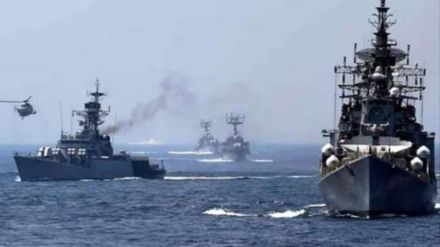India and Kenya have solidified their commitment to enhancing maritime security cooperation, aiming to strengthen existing mechanisms and establish new institutional frameworks. The India-Kenya Joint Defence Cooperation Committee, instituted in 2016, serves as a cornerstone in this strategic partnership. Both nations, representing a combined maritime region crucial for global trade and commerce, recognize the vast opportunities for mutual benefit in goods, services, investment, and technology.
At the end of talks between Prime Minister Narendra Modi and the visiting Kenyan President William Samoei Ruto, India- Kenya Joint Vision Statement on Maritime Cooperation in the Indian Ocean Region – “BAHARI” was released.
According to the Joint Vision statement, trade facilitation measures, logistics links, and the promotion of a sustainable fishing industry are key considerations for India and Kenya.
This includes collaboration in the shipbuilding industry, focusing on capacity building and co-development of defence equipment like maritime surveillance tools, offshore patrol vessels, fast attack crafts, and other essential resources necessary for Kenya’s maritime forces.
“Maritime security cooperation takes precedence, addressing issues such as piracy, armed robbery, maritime terrorism, illegal fishing, human migration, contraband smuggling, and emerging threats. Both nations acknowledge their roles in the Indian Ocean Rim Association (IORA) and the Indian Ocean Naval Symposium (IONS), emphasizing the need for a comprehensive approach to maritime security,” the vision document states.
Also, Humanitarian Assistance and Disaster Relief (HADR) are integral aspects of the partnership. This involves strengthening cooperation to respond effectively to natural disasters, providing timely humanitarian assistance, and building capacity for disaster management in Kenya. Additionally, early warning systems in the region for disaster-related risks are a focal point.
In-ship visits, joint exercises, and participation in multilateral frameworks like Djibouti Code of Conduct-Jeddah Amendment (DCOC-JA) and Contact Group on Illicit Maritime Activity (CGIMA) are identified as essential elements in strengthening maritime ties, according to the document.
Both nations commit to participating in regular dialogues, meetings, and information-sharing networks to address common challenges in a coordinated manner.
Recognizing the potential of the Blue Economy, India and Kenya plan to finalize a Memorandum of Understanding in the Blue Economy and Fisheries Sector. This aims to harness the potential of fisheries, aquaculture, renewable energy, and marine biotechnology while promoting sustainable development and conserving marine resources.
In the vision document, enhancing connectivity is deemed crucial for trade, tourism, creative industries, and B2B linkages. Investment and cooperation in ports are highlighted to facilitate the smooth movement of goods, reinforcing connectivity in the region.
India commits to extending capacity-building assistance to Kenya, covering oceanography, ship design and construction, dredging, welding, fisheries, port development, and research capacity. The stress is on transferring marine technology among research and development institutions.
Information sharing related to maritime security in the Indian Ocean Region is a key aspect of the partnership. Both nations agree to enhance information sharing through networks like the Information Fusion Centre – Indian Ocean Region (IFC-IOR), contributing to Maritime Domain Awareness. India offers collaboration opportunities, including providing a slot for an International Liaison Officer representing Djibouti Code of Conduct-Jeddah Amendment at IFC-IOR and an Indian Naval Officer as an instructor at Kenya Navy Training College.
The comprehensive vision laid out by India and Kenya reflects a cooperative approach to maritime security, economic development, and technology transfer, strengthening their strategic partnership in the maritime domain. This collaborative effort, grounded in shared interests and goals, underscores the significance of bilateral cooperation in navigating the complexities of the maritime landscape.
